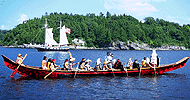 |
War Canoes
The Haida were known as raiders -- "Vikings of the North Pacific" -- and were feared in villages from Sitka, Alaska to northern California.
Haida artist Bill Reid created a 15-metre red cedar war canoe for Expo 86 in Vancouver. He named it Lootaas, or Wave Eater. His dugout has been paddled up the Seine River to Paris, as well as to the Queen Charlotte Islands, where it is now kept at the village of Skidegate.
This fibreglass canoe, named Red Raven was moulded from the hull of Lootaas. Bill Reid designed its sails and paddles. Raven, Eagle and Thunderbird are depicted on the sails. The grizzly bear on the prow and the beaver on the stern are additions that were collected on the islands by Israel W. Powell, British Columbia's first Indian Commissioner, in 1879; such figures were added for ceremonial occasions and removed when the canoe had to be stripped for battle.
 |
 |
 |
Black Eagle, a sister canoe to Red Raven, is operated by the Canadian Museum of Civilization every summer on the Ottawa River. It is shown above participating in an historical re-enactment (August 1996) of the encounter between the Lady Washington,, one of the earliest American trading vessels to come to the waters of the Queen Charlotte Islands, and the Kunghit Haida of the village of Ninstints, a warlike people. Although the first visit of the Lady Washington resulted in amicable trade, when the ship returned later in 1789 hostility grew between the Haida and the white traders. Pilfering of minor items from the ship led to a violent and irrational reaction. The captain ordered two chiefs seized and he held them as hostages. To avenge their humiliation, the Ninstints chiefs led raids on passing ships. The last attack was in 1795 on the ship Union under Captain John Boit, who recorded that:
| "Above 40 Canoes Came into the Cove, full of Indians, at least 300 men. I immediately suspected by their manoeuvres that they meant to attack the Union.... the war Canoes kept pressing alongside, & the Indians getting upon the Nettings.... the Indians alongside attempted to board, with the most hideous yells." |
 A cedar canoe of this type, built in 1908, is displayed in the Grand Hall. The canoe was built for the Seattle Exposition.
A cedar canoe of this type, built in 1908, is displayed in the Grand Hall. The canoe was built for the Seattle Exposition.
| As it was being towed by steamer from Masset, across the Hecate Strait to Prince Rupert, a storm blew up, breaking the tow-line. The Haida man and his wife who were in the canoe hoisted the sails and the canoe glided along on top of the waves at great speed. When the steamer arrived at Prince Rupert harbour, the captain was surprised to see the canoe already tied up at the dock. The canoe managed to outstrip the steamer, a clear demonstration of the canoe's excellent design that allowed it to navigate the high seas without losing speed. taken from: Nancy Ruddell, Raven's Village (Canadian Museum of Civilization, 1995). |
| kayaks | umiaks | bark canoes | dugout canoes exhibition photos | conservation | bibliography | other WWW resources credits |
 |
